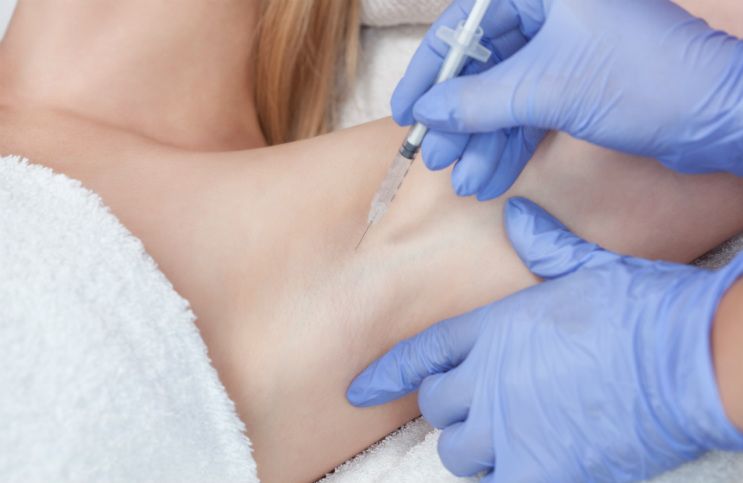In our recent post: 7 Possible Triggers of Hyperhidrosis, we shared seven common factors that can cause excessive and unpredictable sweating. One of them was menopause. But why exactly does menopause bring about hyperhidrosis, and is there anything you can do to rein in the sweating? Read on to find out!
Why Menopause Causes Excessive Sweating
Did you know that onset of excessive sweating is one of the first and most common indications of impending menopause? For many women, this can start in their 40s. But some women notice changes as early as their mid-30s.
A common theory is that decreasing levels of estrogen contribute to excessive sweating. Once menstrual cycles stop, a woman will often experience a dramatic drop in the level of estrogen in their body. This plunge in estrogen is thought to affect the hypothalamus (part of the brain that regulates body temperature) in such a way that even small changes in external temperature can cause a core rise in body heat.
Sweating is the body's natural way of keeping itself cool and keeping your internal temperature stable, so the body induces sweating when its core temperature increases. This often will result in a hot flash and a rapid increase in sweat.
That being said, this is only one of the theories about the relationship between menopause and excessive sweating. Other theories are:
- Skin sensitivity increases during menopause, making women more prone to vasodilation (widening of blood vessels due to the relaxation of the blood vessel's muscular walls) and hot flashes.
- Research also suggests that an imbalance in levels of the hormone leptin and a drop in blood sugar may contribute to hot flashes and hyperhidrosis during menopause.

The Downsides of Excessive Sweating Among Women Due to Menopause
Although hyperhidrosis does not generally present a health risk, it can be embarrassing to those suffering from the condition. While sweating is a normal biological response that regulates body temperature, excess amounts can be socially isolating, with many people finding the condition quite upsetting.
People with hyperhidrosis often avoid shaking hands or shy away from attending professional or social functions where they may perspire even more due to feeling anxious. Others sweat so much they need a change of clothes once or several times in a day.
How to Reduce Menopause Hyperhidrosis
Hot flashes and excessive sweating are considered to be normal physiological changes that occur during menopause. That being said, It may be beneficial to look into some of the ways you can cope with persistent menopause sweating symptoms.
Menopause hormone therapy
Menopause hormone therapy consists of replacing a woman's lowered estrogen levels with artificial estrogen. This is one of the most effective reliefs for hot flashes, night sweats and other troublesome menopausal symptoms. Common side effects of taking artificial estrogen include breast tenderness or swelling, leg cramps, headaches, indigestion and vaginal bleeding. The good news is that these side effects often subside with time.
While very effective in tapering symptoms of menopause, hormone therapy has been associated with a higher risk of developing heart disease, blood clots, stroke, and breast cancer.
If you are considering menopause hormone therapy, it's essential you talk to your doctor about the potential benefits and drawbacks of this option.

Botox for Excessive Under Arm Sweating
Many women struggle with a significant increase in their underarm sweating during menopause. The good news: Botox, the anti-ageing miracle drug, happens to be one of the best ways to take care of excessive underarm sweating! Botox blocks the nerve signals responsible for sweating, stopping the sweat glands from producing too much sweat.
Botox has been a revolutionary treatment for hyperhidrosis. In fact, the FDA approved Botox for treating underarm sweating more than 15 years ago. The International Hyperhidrosis Society puts the efficacy of Botox injections for reducing underarm sweating at 82%–87%—which means it works really well.
The only downside is that the effects typically last 4–12 months before you have to get another treatment to continue keeping the excess sweat at bay. Over time, however, patients can go longer between treatments.
Studies have found that other than underarms, Botox can also successfully treat sweaty palms. Here, at Dr Aesthetica in Birmingham, Botox for Underarm Sweating is one of our speciality treatments. Take a moment to learn more about our services here.

Lifestyle Changes
There are numerous simple lifestyle changes a woman can make to help them better cope with menopausal hyperhidrosis. It's important to note that every individual is different. What works for one woman might not necessarily work for the next. A few examples:
- Excessive sweating often accompanies hot flashes, so wear light clothes to help you stay cool or dress in layers so you can remove them when a hot flash strikes.
- Many scientists agree that maintaining a normal weight and having a regular exercise routine can help reduce the frequency and intensity of hot flashes and menopausal hyperhidrosis.
- Pay attention to potential triggers. Some women might have triggers that exacerbate hot flashes and excessive sweating. This can be anything from drinking caffeine, eating spicy foods to being overly stressed.

Final Thoughts
Hyperhidrosis is a common condition that affects not only women in menopause but a wide range of people. It's been estimated to affect between 1 and 3 in every 100 people, which means there are likely to be hundreds of thousands of people living with it in the UK.
But there is hope! Advancements in treatment options in recent years now allow women in menopause and other people suffering from excessive sweating to manage this condition better.
Are you suffering from excessive underarm sweating? Then we can be of great help to you. Talk to us today to learn more about how Botox can provide you will significant and long-lasting relief. It's time to say goodbye to those long days of drenched armpits.


